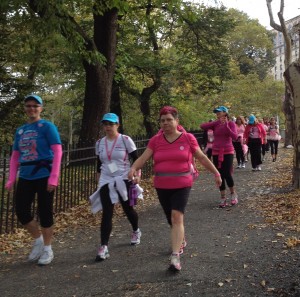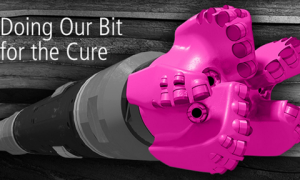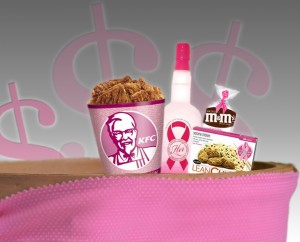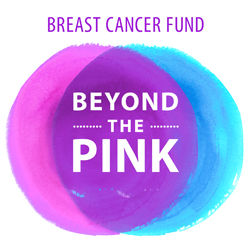Prepare yourselves –
this is an anti-pink post. If you’re just back from your local Breast Cancer Awareness Walk or happily clicked on that ‘donate a mammogram’ button, be prepared.

Before you dismiss my forthcoming comments as an angry rant from someone just transitioning back to the USA, note: I am not an unfeeling person, untouched by chemotherapy in the family or blissfully absent the experience of death.
My mother is a breast cancer survivor. My mother-in-law died of cancer, in her early 50’s, never to see most of her grandchildren. My beloved step-brother died of AIDS in the 1980’s, back when sufferers were quarantined and feared, way before life-saving drug cocktails and smiling multi-racial couples in “HIV+” public service posters on the subway. I have spent much of my adult life working in developing countries where health care – basic health care – is NOT taken for granted. I am not an insensitive crank.
But think.
Buying a plastic PBA laden water bottle with Save a Sister emblazoned in fuchsia? Football players sporting pink gloves? Macho, sexy looking Timberlane boots for men – in hot pink? Pink drill bits courtesy of, catch this…a fracking company collaborating with the already scandal-tainted Susan G. Komen Foundation? This is how we’re going to defeat breast cancer? Have we lost our marbles? Is all this pink-ribbon buying and tee shirt wearing really defeating breast cancer?

Short answer: No. It’s not. It’s pinkwashing, plain and simple.
Okay, you might say, all that uber-visible pink is to grab our attention, to raise our ‘awareness,” like the pink plastics in the Toys ‘R Us aisle beckons to little girls.
We’re aware already, for Pete’s sake. How stupid do people really think women are? My god, we’re drowning in awareness. “Awareness” is not the problem.
The real problem is we are unwilling to investigate causes and connect the dots. The real problem is we don’t challenge companies that profit from lax regulation of toxins linked to cancer. The real problem is that most research money goes to fund pharmaceutical treatments and diagnostics, with ‘prevention’ money spent only on encouraging mammograms.
And the REAL problem is that these efforts distract our attention and divert our energies from political and social solutions, perpetuating the notion that we can shop or walk our way out of systemic, culturally rooted health problems.
Those purchases, those vast corporate marketing campaigns, those products and posters, they all take advantage of a very genuine desire to do something and then channel it into consumption and trust in corporations to do the right thing.

I personally do not think we can consume our way out of breast cancer and I for one do not think Avon, Lane Bryant, Chevrolet, Barclays Bank, and the NFL are suitable impartial guardians of my health research dollars.* I just don’t. I’ll buy an Avon lotion if I want to keep bugs away, and happily watch the football game for Sunday entertainment, but I don’t trust them with medical research decisions.
And the research groups which DO get some of the money from all these efforts, however small the percentage? Most simply keep the focus on mammograms and drugs, dumping the burden back on women with a misguided obsession on early detection – as if early detection were the same thing as prevention – while carefully avoiding tough questions like causes, reasons for increasing rates, inequities of care, health care affordability and access.

Many studies document the dramatic increase in breast cancer rates among immigrants to the USA. For example, women who immigrate to the United States from Asian countries, where the rates are four to seven times lower, experience an 80 percent increase in risk after living in the United States a decade or more (Stanford, 2005; Ziegler, 1993).** Similar results are apparent for Hispanic women. (For more on this, see good summaries by the Breast Cancer Fund here.)
These studies mean there is something about just living in the US which raises rates: shouldn’t that put us on notice?
Of course early detection is important, but how about reducing incidences to detect? I do not find it acceptable to obsess about early detection and genetic markers without addressing environmental factors.
So here’s my take on what the Pinkwashing of October does and does not do:
Pink October Does Not
- Make people aware of the connections between environmental factors and breast cancer, links which are grossly under-publicized and under-researched.
- Address the inequalities of health care in our system. (Why should black and Latino women suffer more? Or low-income women? Or women from rural areas?)
- Harness the huge amounts of time, energy, money, organization, and goodwill to combat the real causes of cancer.
- Reduce the pharmaceutical industry’s extensive involvement – otherwise known as a ‘conflict of interest’ – in the breast cancer research industry.
Pink October Does
- Increase profits for companies who most want to ‘look good’ to women: Avon, Sally Beauty, Estee Lauder, the list goes on. Please. Buy their products if you want, but don’t kid yourself that it all goes to a good cause. Look up their corporate charity policies or see the links below.
- Distract women – and men – from political activities which might actually prevent breast cancer such as reducing environmental causes and increasing high-quality, free public health services.
- Play into the ‘appropriate role’ of women: to suffer along with those in need (“Every Blister Saves a Sister”) while avoiding confronting those in power or actually challenging any authority figures. Don’t let yourself be trivialized into ‘shop therapy.’
- Further the sexist connection of breasts as objects for public fun (“save the tatas”, “keep the headlights on,” “save our hooters”). Hmm… how about making it publicly acceptable to breastfeed anywhere, something which might actually help to reduce breast cancer?

Don’t just take it from me. Do a little research. I’ve listed just a few informative sites below. Think for a minute about all that goes into these mega-walks. What if that woman-power were diverted? What if all those women walked to their Senator’s office and spent the morning there, camping out, chatting, wearing whatever the hell color they wanted, until the Senator agreed to serious regulations of toxins linked to breast cancer? THEN you’d have a walk to cheer about.
So if you really want to walk, or jog, or buy yet one more unnecessary pink-ribbon bedazzled item, go ahead. If the pink shoelaces remind you of mom or the pink water bottle on your desk gives you hope that your best friend will be alive to see her grandchildren, have at it. I will not deprive you of that.

But please, in addition, consider just a few of the many alternatives:
Then you can walk more freely, fully informed!
____________________________________________________________
